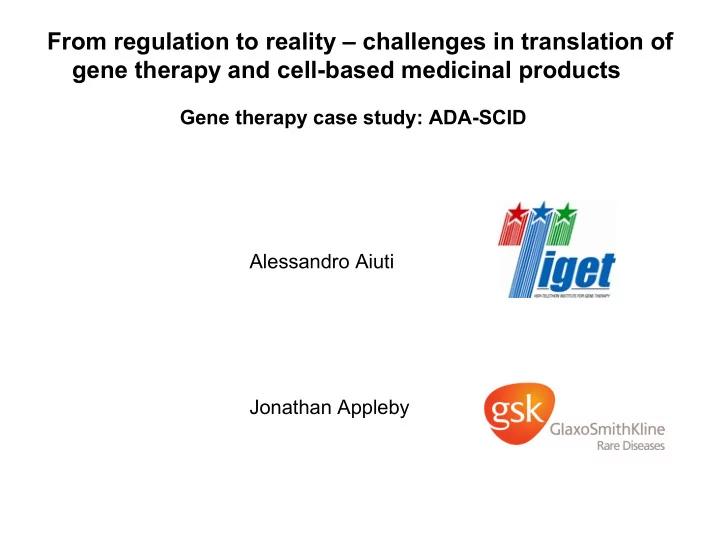

From regulation to reality – challenges in translation of gene therapy and cell-based medicinal products Gene therapy case study: ADA-SCID Alessandro Aiuti Jonathan Appleby
HSR-TIGET is focused on the implementation of basic and clinical research for genetic diseases • HSR-TIGET is a joint venture between Telethon and San Raffaele Hospital HSR-TIGET Structure ( HSR ) San • Telethon HSR-TIGET has a Research staff of 93 Raffaele Foundatio people , including 4 heads of unit, 10 Foundatio n group-leaders/project leaders, 59 junior n Overview researchers, and 20 technicians • HSR-TIGET HSR-TIGET has also established a Pediatric Clinical Research Unit that focuses on the diagnosis, treatment and Basic Clinical follow up of patients, including those Research Research enrolled in the gene therapy trials • State-of-the-art research in gene transfer technologies and gene and cell therapy strategies • Genetic diseases currently under investigation include: – Primary immunodeficiencies Research – Thalassemia – Autoimmune diseases – Leukodystrophies – Other lysosomal storage disorders 2
As research progresses, funds to therapeutic approaches are increasing (approx. 30% of Telethon funds) TELETHON INVESTMENTS BY STAGE/TYPE OF RESEARCH (% OF TOTAL ALLOCATED FUNDS) 1991-1995 €32mn 2005-2009 €101mn 58% 57% Therapeutic Approaches 30% (2005-2009) vs. 9% (1991-1995) ADA-SCID 10% 3% Treatments 11% Therapeutic clinical trials 2% 29% 8% 4% Therapeutic approaches in vivo Diagnostic, Therapeutic approaches in vitro observational 9% and palliative trials Studies on mechanisms 4% 5% Genetic studies DISEASE 3
ADA-SCID Immunodeficiency Infections Autoimmunity NK cell T cell Adenosine B cell CLP deaminase PSC HSC Organ alterations dAdo, Ado dAXP Autosomal recessive 1:375,000
RATIONALE FOR GENE THERAPY Scientific rationale • The ADA gene is constitutively and ubiquitously expressed • Correction of HSC could correct the defect in all blood cells • Gene-corrected lymphocytes have an advantage over ADA-deficient cells. • 10% of normal ADA expression may be sufficient Unmet medical need • 90% of children lack an histocompatible donor in the family • High risk of bone marrow transplant from alternative donors • Treatment with bovine enzyme (PEG-ADA) requires weekly administration, not always effective and very expensive
Gene transfer protocol into autologous bone marrow CD34 + cells Medicinal Product: Autologous transduced cells BM Harvest No PEG-ADA Busulfan 2 mg/Kg/day x 2 (days -3, -2) Day -4: Purification Day 0: Infusion of BM CD34 + cells SV Neo ADA MLV LTR Days -3 to -1: Day-4: Prestimulation 3 cycles of transduction (TPO, FLT3-ligand, on retronectin + cytokines SCF, IL-3)
Multilineage stable engraftment Granulocytes 100 % of vector of positive cells 10 1 0.1 <0.01 0 1 2 3 4 5 6 7 Years after GT Improved T- cell counts T cells 2500 100 % of vector of positive cells 2000 10 1 1500 0.1 1000 <0.01 500 0 1 2 3 4 5 6 7 Years after GT 0 0 12 24 36 48 60 72 84 Months after GT N=14 Aiuti et al. NEJM 2009 and unpublished data
Development of gene therapy for ADA-SCID 2012 2000 2008 2009 2010 2011 2002 2005 Pilot Studies Phase I/II study Long-term FU FDA Orphan drug EMA designation Protocol assistance GSK/MolMEd CMC and preclinical activities Telethon GSK 8
Academia and industry joining forces for developing ATMP • Basic studies on disease mechanism • State of the art research in gene transfer technology • Expertise in non clinical models for safety and efficacy of ATMP • Pediatric clinical trial center with experience in ATMP • Knowledge of specific regulatory aspects in this field • Manufacturing to industrial scale • Development of commercial Quality Systems • Patient Access • Pharmacovigilance
Practical Challenges • Rare Populations • Local vs Global regulations • Duration of follow up – EU and FDA guidance – Pharmacovigilance and risk assessment / mitigation plans • Safety Assessment – Bespoke complex studies with limited background information • Manufacturing – Industry Leading Standards
Recommend
More recommend